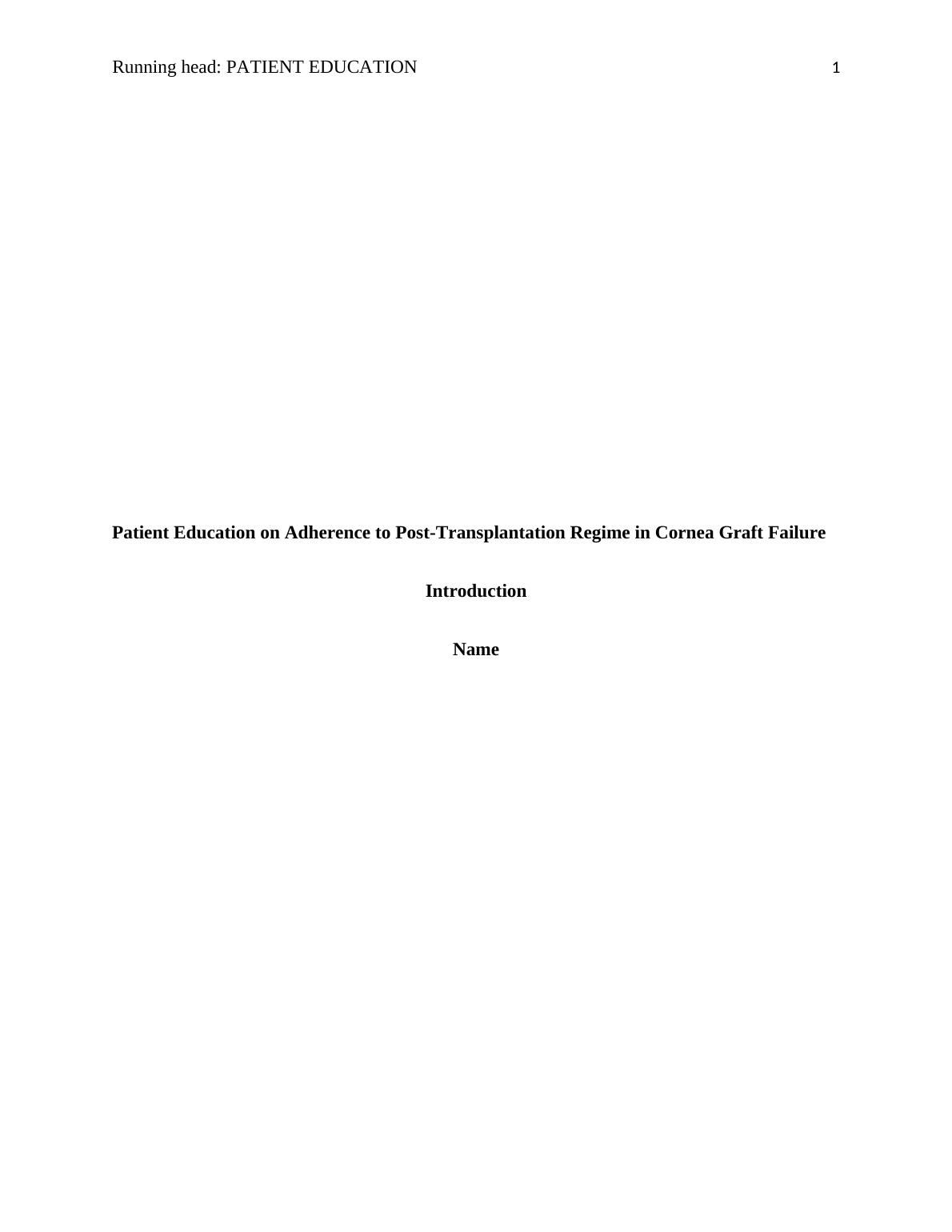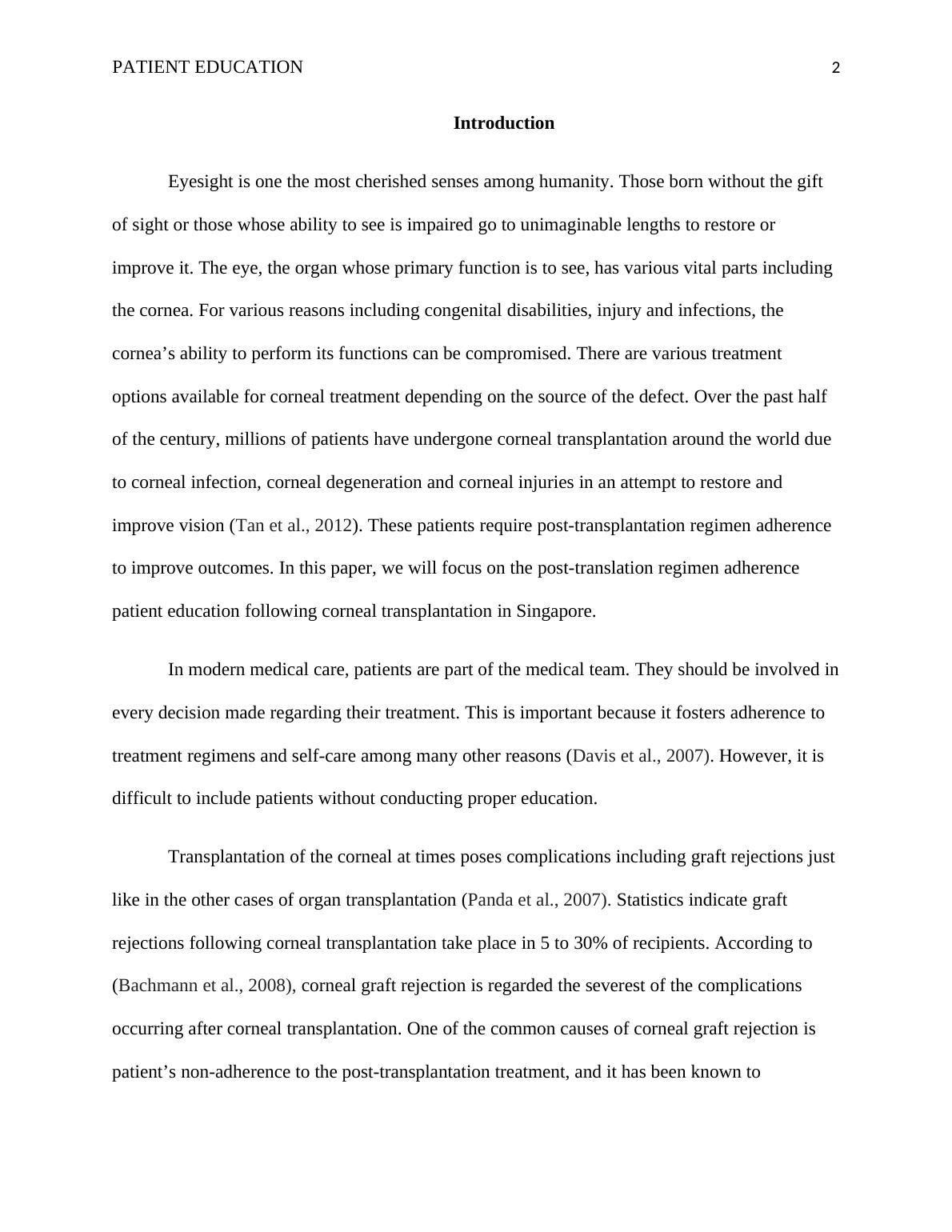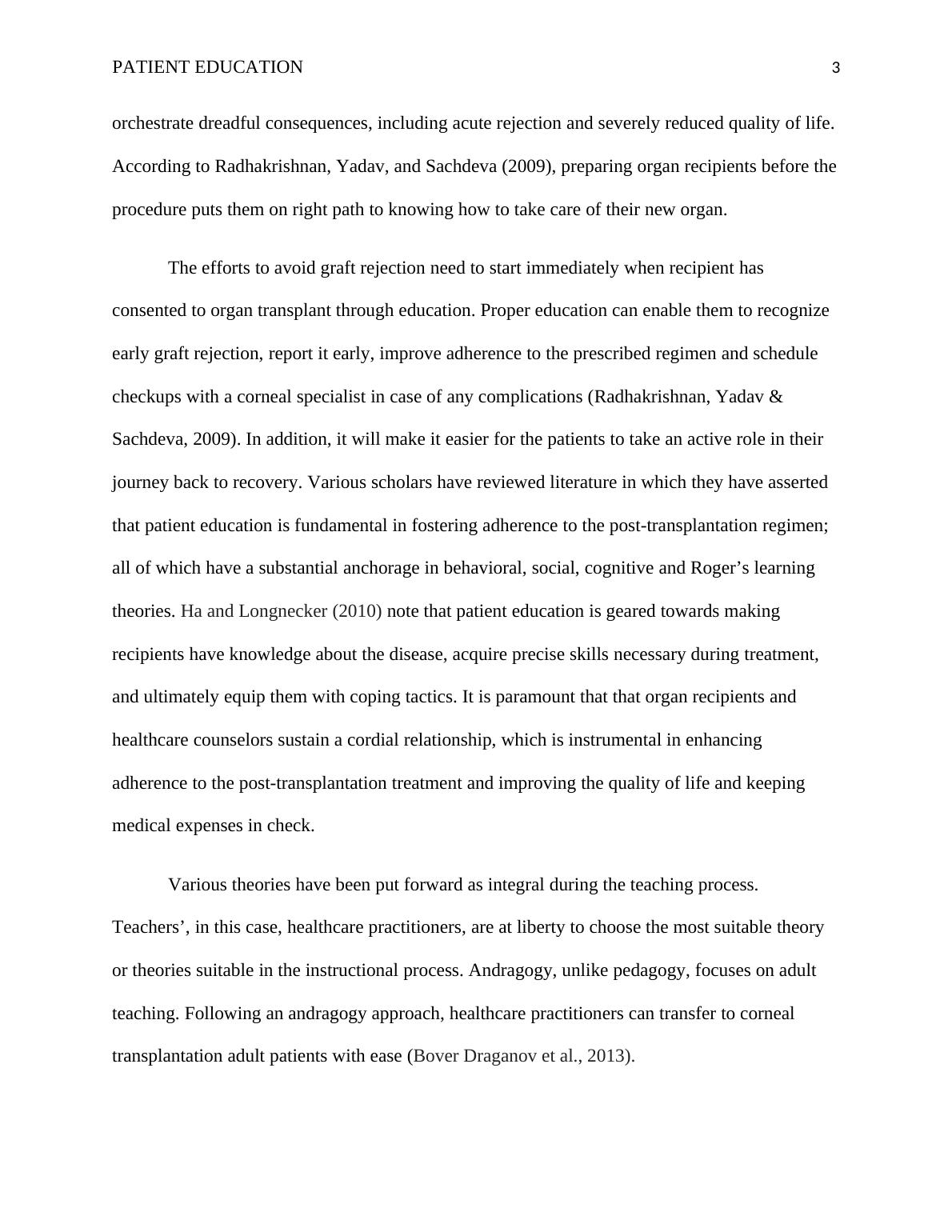Post-translation Patient Education in Corneal Transplantation : Paper
Added on 2020-02-24
12 Pages2899 Words55 Views
Running head: PATIENT EDUCATION1Patient Education on Adherence to Post-Transplantation Regime in Cornea Graft Failure IntroductionName

PATIENT EDUCATION2IntroductionEyesight is one the most cherished senses among humanity. Those born without the gift of sight or those whose ability to see is impaired go to unimaginable lengths to restore or improve it. The eye, the organ whose primary function is to see, has various vital parts including the cornea. For various reasons including congenital disabilities, injury and infections, the cornea’s ability to perform its functions can be compromised. There are various treatment options available for corneal treatment depending on the source of the defect. Over the past half of the century, millions of patients have undergone corneal transplantation around the world due to corneal infection, corneal degeneration and corneal injuries in an attempt to restore and improve vision (Tan et al., 2012). These patients require post-transplantation regimen adherence to improve outcomes. In this paper, we will focus on the post-translation regimen adherence patient education following corneal transplantation in Singapore. In modern medical care, patients are part of the medical team. They should be involved inevery decision made regarding their treatment. This is important because it fosters adherence to treatment regimens and self-care among many other reasons (Davis et al., 2007). However, it is difficult to include patients without conducting proper education. Transplantation of the corneal at times poses complications including graft rejections just like in the other cases of organ transplantation (Panda et al., 2007). Statistics indicate graft rejections following corneal transplantation take place in 5 to 30% of recipients. According to (Bachmann et al., 2008), corneal graft rejection is regarded the severest of the complications occurring after corneal transplantation. One of the common causes of corneal graft rejection is patient’s non-adherence to the post-transplantation treatment, and it has been known to

PATIENT EDUCATION3orchestrate dreadful consequences, including acute rejection and severely reduced quality of life. According to Radhakrishnan, Yadav, and Sachdeva (2009), preparing organ recipients before theprocedure puts them on right path to knowing how to take care of their new organ. The efforts to avoid graft rejection need to start immediately when recipient has consented to organ transplant through education. Proper education can enable them to recognize early graft rejection, report it early, improve adherence to the prescribed regimen and schedule checkups with a corneal specialist in case of any complications (Radhakrishnan, Yadav & Sachdeva, 2009). In addition, it will make it easier for the patients to take an active role in their journey back to recovery. Various scholars have reviewed literature in which they have asserted that patient education is fundamental in fostering adherence to the post-transplantation regimen; all of which have a substantial anchorage in behavioral, social, cognitive and Roger’s learning theories. Ha and Longnecker (2010) note that patient education is geared towards making recipients have knowledge about the disease, acquire precise skills necessary during treatment, and ultimately equip them with coping tactics. It is paramount that that organ recipients and healthcare counselors sustain a cordial relationship, which is instrumental in enhancing adherence to the post-transplantation treatment and improving the quality of life and keeping medical expenses in check. Various theories have been put forward as integral during the teaching process. Teachers’, in this case, healthcare practitioners, are at liberty to choose the most suitable theory or theories suitable in the instructional process. Andragogy, unlike pedagogy, focuses on adult teaching. Following an andragogy approach, healthcare practitioners can transfer to corneal transplantation adult patients with ease (Bover Draganov et al., 2013).

PATIENT EDUCATION4Principle of Patient Education and Adult Learning TheoryPrinciples of Patient EducationPatient learning is guided by various principles. The first principle indicates that the instructor cannot avoid teaching whether intentional or not. Teaching takes place in many ways as healthcare practitioners make contact with their patients including words, actions and nonverbal behavior (Mann, 2011). As such, it is the practitioners’ choice to teach well or not. The second principle reminds the nursing practitioners that teaching is an integral part of the caring process. Good teachings stay with the patients and their families for a long time (Glanz, Rimer & Viswanath, 2008). Studies have established that the impact of teaching is never immediate and may go unnoticed by the healthcare practitioners during physical contact with patients and as such, it should not deter physicians from dispensing the correct amount and quality of education. It is important for the nursing practitioners to assess patient’s knowledge before dispensing more knowledge. Adult patients are likely to have a lifetime of experience and knowledge. The fourth principle of teaching underscores the fact that a good session must embody an introduction, body, and conclusion. It is important for the instructors to introduce themselves during which they should involve the patients in ice-breaking and establishing the goal of the session. It is this stage that nursing counselors need to build their anticipation of the learning session. For instance, the nurse educators can identify things that they expect the patients to perform at home (Mann, 2011). The second phase is all about the body. The information should be delivered with patient involvement. It should be planned carefully to ensure patients grasped key concepts. Simple information communication materials may be used to convey the main points. The instructor can start the conclusion part of teaching sessions by asking the patients to

End of preview
Want to access all the pages? Upload your documents or become a member.
Related Documents
Diploma of Community Services : Renal Transplantationlg...
|34
|8441
|29
Renal Transplantation: Definition, Pathophysiology, and Managementlg...
|12
|3128
|491
Biomedical Engineering Research Paper 2022lg...
|12
|2719
|25